Cloud Mountain Retreat Center Expands
Dining Room, in Mindful Stewardship
Written by: Laura Hauer
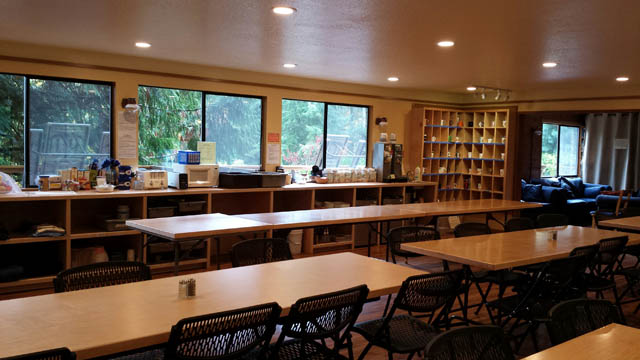
The final result: The enlarged dining hall, with plenty of space for all retreatants.
Photos by Laura Hauer
Cloud Mountain Retreat Center recently completed a transforming renovation of its main building, expanding capacity and upgrading elements of its dining room and several other areas.
The bulk of the recent renovations were completed during a rare, carefully structured break in the retreat schedule that allowed for the tearing down and reconstruction of the dining area. The majority of the work was completed during March and April of 2015, with the final details completed over the summer and early fall.
Cloud Mountain is a non-sectarian Buddhist retreat center located in rural southwest Washington near the town of Castle Rock. Founded in 1984, it has operated as a residential meditation retreat center hosting retreats from all Buddhist traditions, serving the Northwest sangha and the dhamma for over 30 years.
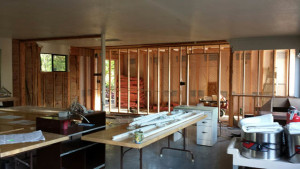
The destruction of the old dining area before reconstruction of the new.
The renovation was funded by two generous local donors who regularly attend retreats at Cloud Mountain. It was their intention to see the dining room expanded to allow every participant to have a seat at a dining table even on full retreats.
Prior to the renovation, retreatants were spread between seats in the dining room, the couches in the adjacent sitting area and – in good weather – the picnic tables on the deck outside. With the expansion of the interior space by just 3 additional feet, it was possible to add enough tables and chairs to accomplish this goal.
“Cloud Mountain has done a wonderful job with the recent renovations to the dining hall,” said Drew Ebersole of Tacoma. “They have maintained the integrity and simplicity that are their hallmarks, and yet made it more spacious and comfortable for retreatants to mindfully, and peacefully, enjoy a delicious meal together.”
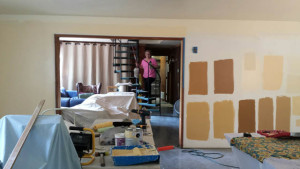
When it comes to choosing among paint swatches, they do things in a big way at Cloud Mountain.
The renovation included a long list of other improvements that were completed at the same time.
“It was thoughtfully designed, addressing issues of congestion at entry, space for personal items and crowding,” said Kay Myers, who often volunteers, and does retreats, at Cloud Mountain.
Myers said the double door entry, with nearby cubbies and coat hooks, makes it easier to remove shoes, hang jackets, and store personal items out of the elements. The extra space in the dining room makes meal time less stressful, because there’s room for everyone to easily sit down and rise, without disturbing others.
“The new counters, extra refrigerator, yogi food storage and cup cubbies again are thoughtfully planned, taking into account yogis’ needs for some personal space around food and drink,” she said. “Overall the feel is cleaner and brighter and roomier. “
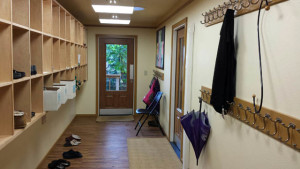
The completed mudroom (facing east). Personal cubbies on left, coat hooks on right, energy-efficient lighting above, dry floor below – no more wet socks upon entering!
Another improvement is a new sink for people to easily fill water bottles and to wash their tea cups.
The tables and shelves that had held food-service and household items were replaced with built-in shelving to utilize storage space more efficiently. New flooring was put down to replace the old, cracked linoleum, not only in the dining room but throughout the entire first floor of the main building.
“The changes are lovely and make it easier to move through the dining area,” said Anne Ihnen, of Mercer Island. “Yet they maintain the hominess of Cloud Mountain, which has always been such a comfort to me on retreat.”
Energy Upgrades
Cloud Mountain took the opportunity during the renovation to upgrade energy efficiency throughout the main building, to lighten our carbon footprint.
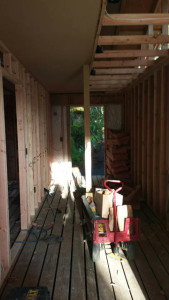
The entry, known as the mudroom, being framed.
Those energy efficiency improvements included installing LED lighting in the dining and sitting rooms; a hybrid hot water heater using heat pump technology to replace an old, less-efficient hot water heater in the dishwashing room; and a beautifully silent, ductless heat pump system to provide both heat and air conditioning in the dining and sitting rooms.
Certain philosophical organizational priorities guided how the renovations were implemented. As an expression of what she terms “our organizational dhamma,” Executive Director Laura Hauer said “middle-way mind” was a primary consideration, as she drew up the designs and executed the plans.
“We wanted an aesthetically pleasing result, of course,” she said. “But we were also bearing in the mind our responsibility to practice wise stewardship of the donations that funded this project, and wanting to be as impeccable as possible in aligning our approach with our commitment to practicing simplicity and renunciation as a dhamma center.”
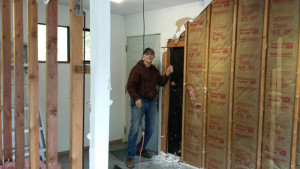
A cameo appearance by Dhammadasa David Branscomb, founder and builder of Cloud Mountain Retreat Center, who for the first time did not lead the project.
The inner view of the building project
Referring to jokes about the “upper middle way,” Hauer said she and the Friends of Cloud Mountain Board found it important, during the design process, to be mindful of the cultural tendency to think that it’s important to keep making things bigger and more polished.
“For example, does ‘new and improved’ have to equate to larger and fancier? Or, is bigger really better?” she said, adding Cloud Mountain leaders have kept the retreat center small out of choice. “The thought process that gets us to our end result feels to me as important as the result itself.”
That thought process, of impeccably and mindfully assessing intentions, is in evidence as Hauer and the Friends of Cloud Mountain Board develop another upcoming major construction project.
Planning is underway to construct 12 small individual sleeping cabins, along with a new shower house to serve cabin residents, in a recently cleared area below the lower parking lot. These plans must be approved by county building and planning authorities.
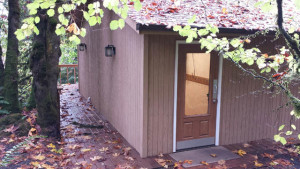
The new northeast entry to the dining hall. An old, giant leaf maple determined the final width of the new walkway around the north end of the building.
Hauer and the Friends of Cloud Mountain Board are examining each aspect of those plans – as they did with the dining hall renovation – with an eye not only to containing construction costs, but also costs that could be passed on to future retreatants.
“One of our primary goals as a dhamma center is to maintain access to the teachings for as many people as possible,” Hauer said “Access and affordability go hand-in-hand. I’m looking at the impact of what we build not only from the perspective of what it will cost in both dollars and energy at construction time, but also further down the road. The complexity and extent of what we construct now, requires constant, ongoing maintenance later on.”
While volunteers can take care of some of this additional work, Hauer said Cloud Mountain will likely have to hire additional staff to take care of the upkeep. She added that additional staff likely will require increases in Cloud Mountain’s retreat fees.
“So it becomes an ongoing point of reflection, a kind of organizational mindfulness practice in any project we undertake – are we serving needs or preferences? How simple can we keep the retreat environment and still adequately meet the genuine needs that arise?” Hauer said. “How do we keep our economic footprint as light as possible in charging retreat fees, but still have adequate hands-on help to keep Cloud Mountain running smoothly?
“These considerations are part of our ongoing practice,” she said, “and come very much to the forefront when we engage in substantial renovation or construction projects.”
